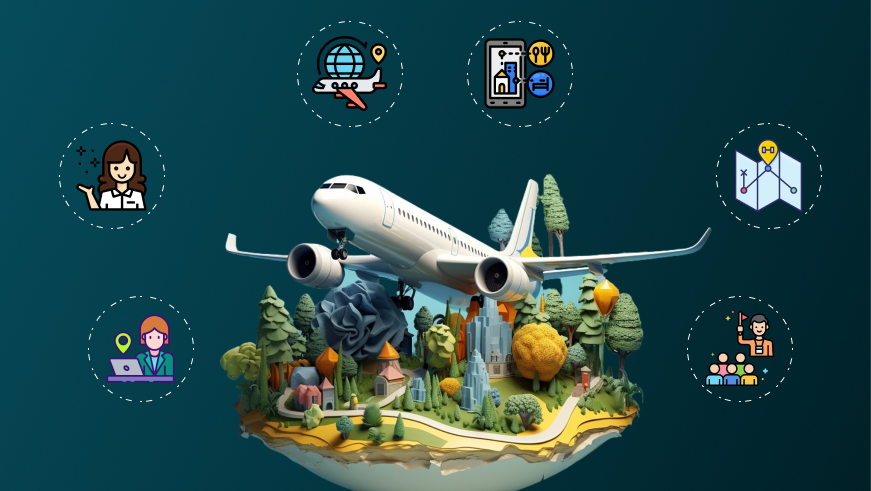
Seamless Synergy: Connecting Airlines and Travel Agents for Effortless Travel
Convenience, speed, and efficiency have evolved into the defining elements that both consumers and companies in the fast-paced travel market of the year demand. Staying ahead in a world going more and more digital is not a luxury for travel agencies; it is a need. The integration of flight APIs is among the most transformative instruments changing the scene. This invention links travel agencies directly with airlines in real-time access to flight data, availability, and booking powers. But what precisely is Flight API integration, and how does it close the distance between travel brokers and airlines?
Let's break it down
Definition of Flight API Integration
APIs, or application programming interfaces, are a set of tools and procedures enabling communication between several software applications. Within the travel sector, a Flight API connection serves as a link between airline systems and travel brokers'. It allows travel agents straight from their own websites or booking systems access to airline data like flight schedules, availability, pricing, and booking choices.
Presenting the two ends—the internal airline system and the booking tool of the travel agent—it is sort of a cross-lingual bridge. The Flight API helps the two to have seamless communication so that knowledge is as fast, precise, and flawless as could be.
The necessity of flawless connectivity
To verify flight availability and bookings, travel agents historically combined hand searches, phone calls, and email exchanges with airlines. Though efficient, this method was sometimes prone to mistakes and time-consuming. It was not the most effective approach to managing a fast-paced sector in which consumers need real-time data and speedy replies.
Moreover, airlines had their systems for handling flight schedules, pricing, and bookings—usually separate from the systems travel brokers utilized. This separation caused travel agents to regularly struggle to provide customers with the most current flight options, leading to delays and less-than-ideal client experience.
But real-time access to airline data became ever more important as digital transformation evolved. Flight API integration fixed this by streamlining the entire process and guarantees faster and more accurate speed.
Main Advantages of Flight API Integration: Real-Time Data
The availability of real-time flight data is most likely the most important benefit of using Flight API. The travel agents no longer have to make phone calls to airlines to verify flight availability or pricing; they are not limited to obsolete knowledge. APIs offer instant access to real-time data, enabling agents to instantly present the most precise and up-to-date flight options to consumers.
Time effectiveness
Book flights usually from different sources using knowledge relevant to that specific travel demand. With the degree of complexity of the research, the outcome could take one several hours. The integration of several flight APIs provided by travel providers allows one to get flight data instantaneously in the same location. This approach not only saves time but also facilitates a more efficient booking procedure, as more customers with less time utilization mean.
Improved Customer Support
Real-time flight data allows travel agents to respond instantly to their clients, therefore improving customer satisfaction and enabling them to create even more close bonds with them. Flight API's real-time integration in agents allows agents to provide their clients with tailored options, including flight schedules and prices, as well as any additional services they could wish for, including seat choice or baggage options, providing an overall better travelling experience for a customer.
Worldwide Availability of Goods
Some travel brokers might concentrate on particular locations or kinds of travel. Still, the travel agency can access the globe via Flight API. An API provides access to world flight inventory via many carriers. Agents can now present large airlines and regional airlines as options, therefore enhancing their client's chances for a decent route and price.
Revenue Growth
Travel agents gain a competitive edge as well from having more options. Accessing the flight inventory gives consumers more options from which to choose, therefore increasing their likelihood of booking. Agents of some flight API providers may add a custom margin on flight reservations. This helps them to turn more profit on every sale.
Flight API integration automates many of the manual chores usually necessary, therefore simplifying the booking process. Travel agents can confirm bookings, issue tickets, and maybe handle payment processing with one click. This flawless procedure guarantees correct and speedy completion of bookings, therefore lowering the possibilities of mistakes.
Flight API Integration's Mechanisms
Implementing a flight API usually means including the booking systems for travel agencies. Most providers let several ways of including the API into the platform of an agent. Every API provides a variety of tools agents might apply based on their requirements. They can choose, for example, the kinds of flight data to access—that which relates to baggage options, seat availability, or cost.
When a travel agent searches for flights using a Flight API, it makes an API request to the airline system. The airline then reacts with flight alternatives, which show on the agent's site. The agent can then proceed to create tickets and bookings simultaneously.
Challenges with Implementation of Flight API
Integration of a flight API presents difficulties even if the advantages are clear-cut. The first one is usually technical complexity. Depending on the platform and API, integration calls for certain technical expertise. This can mean working with engineers to ensure that the travel agent's present systems perform as they should.
Integration maintenance is another difficulty. Updates in flight policies, prices, and laws cause regular changes in APIs for flights. Travel agents have to periodically change their systems to prevent disservice.
At last, several independent or smaller airlines lack API capabilities or have somewhat restricted API capabilities. In these situations, travel agencies could have to rely on conventional means of communication or look for different ways to cover the voids.
Future API Integration for Flight
APIs in flight appear to have a promising future. Further integration of APIs is predicted to be much smarter and simpler as technological developments just keep gathering speed and bring artificial intelligence with them. On the other side, AI-charged chatbots can assist an agent in booking tickets even faster by offering more automated services, while the development of more flight recommendations fit for consumer interest can be presented using machine algorithms.
There will only be more worldwide inventory exposed to the agents to facilitate simple booking for flight possibilities as the world embraces API technology among the airlines. Changing gates and delivering real-time alerts for changes in flights, either by delays or cancellations, will probably be other advantages of this situation.
Conclusion
The integration of the flight API is redefining how travel agents interact with airlines and service their customers. Flight API integration has very strikingly become a basic tool for travel experts since it offers access to real-time data, improves booking processes, and enables access to more choices. In this regard, adopting such technology will be very important in preserving competitive advantages, enhancing customer service, and promoting development in a highly digital environment as the travel sector keeps changing.

 Start your Travel Business with Our 7 Day Free Trial Website!
Start your Travel Business with Our 7 Day Free Trial Website!





